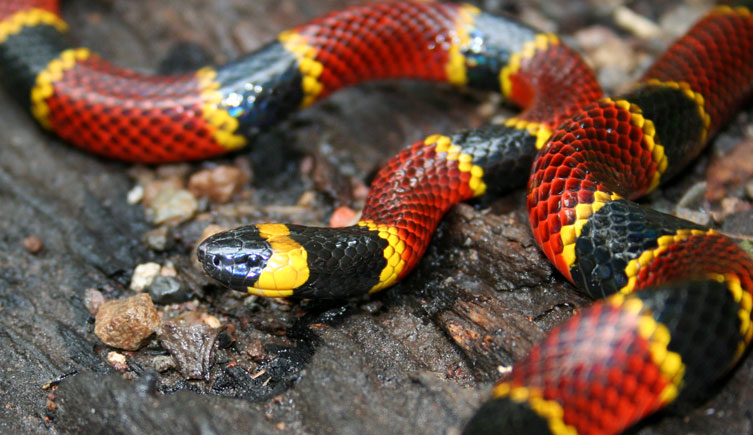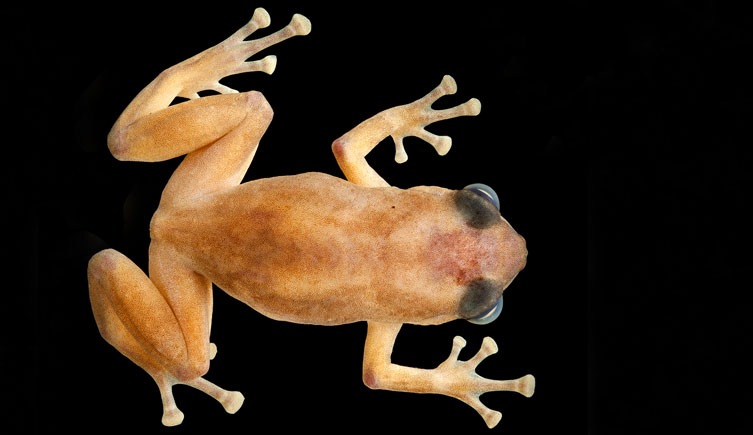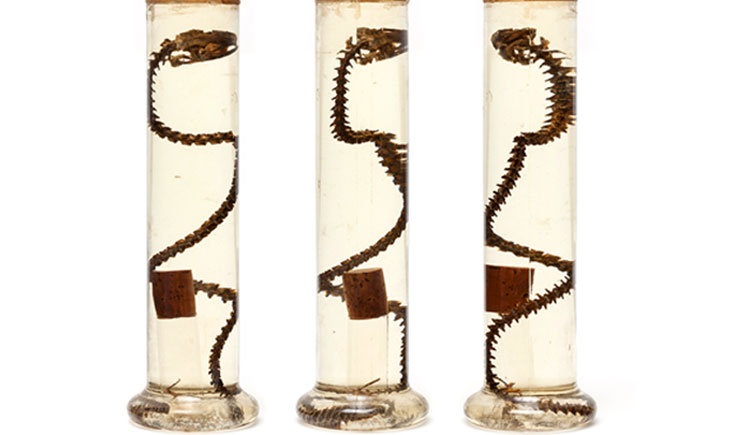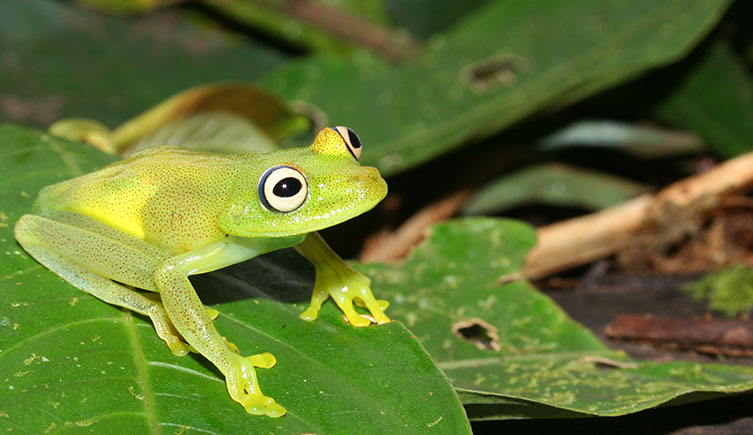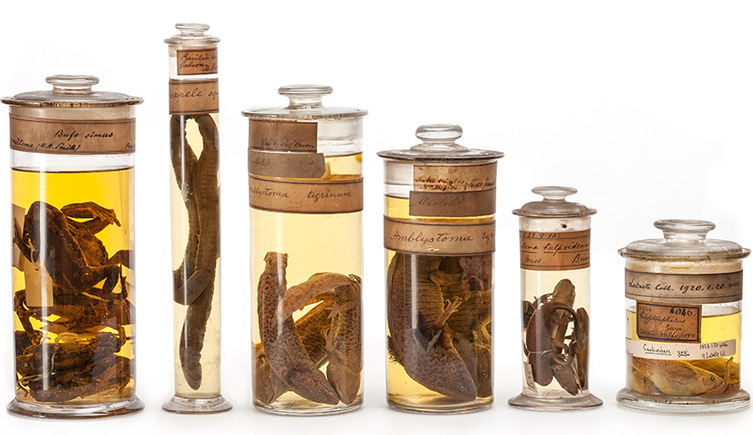
Helmeted toad, Calyptocephallela gayi © The Trustees of the Natural History Museum, London
The Museum's large collection of amphibians and reptiles is one of the longest maintained collections in the world, originating in the late eighteenth century. The collection is particularly notable for the thousands of type specimens that it contains.
Specimens
200,000
Type specimens
8,000
The collection of non-fossil herpetofauna consists of more than 200,000 individual specimens that have been prepared as fluid-preserved specimens, skins, skulls, skeletons, taxidermy mounts and models.
As of April 2021, the collection contained 83,378 jars of alcohol-preserved specimens and 17,493 dry storage specimens. There is also a growing collection of frozen tissues taken from voucher specimens prior to preservation.
The herpetology collection includes over 8,000 types of amphibian and reptile species and subspecies, making it one the most scientifically important collections in the world.
Strengths
The herpetology collection is one of the largest and most taxonomically comprehensive in the world. With most known genera represented, it is a key reference collection for systematic and evolutionary biologists.
Due to the taxonomic and geographical range, the number of preparations and historical depth, it is a highly significant collection for research into a wide range of studies, including those outside of zoology.
It is used by researchers and students from all over the world and on average, we host over 100 visitors per year, including neontologists, palaeontologists, historians, and materials scientists.
Postgraduate students also use the collection as they pursue their degrees in collaboration with institutions like Imperial College London and University College London.
Historical collections
Charles Darwin (1809-1882)
Alfred R Wallace
L Evelyn Cheesman
David Livingstone
Louis Fraser
Lionel Walter Rothschild
Richard H Beddome
Thomas C Jerdon
John Goodman
Specimen exchanges with most major European and North American museums
Malcolm Smith
Frank Wall
Fernand Lataste
Jacques von Bedriaga
Frederick D Godman
Osbert Salvin
Andrew Smith
Malcolm J Largen
Barry Hughes
Museum staff
Dozens of students, scientific associates, and research assistants have contributed to the development and perpetuity of the herpetology collections.
The following is a partial list of permanent staff who have served the collection.
John E Gray (1824-1874)
Albert Günther (1857-1895)
Arthur O’Shaughnessy (1863-1881)
Hans F Gadow (1880-1882)
George A Boulenger (1881-1920)
James C Battersby (1916-1961)
Joan B Procter (1917-1923)
Hampton W Parker (1923-1957)
Alice G C Grandison (1951-1984)
Andrew F Stimson (1961-1991)
Garth L Underwood (1964-1966)
E Nicholas Arnold (1966-2000)
Colin J McCarthy (1970-2011)
Barry T Clarke (1975-2014)
Collection history
Since ca. 2010, the prefix NHM or NHMUK has increasingly been used to report specimens in the collection in publications, reflecting the change in institutional name from British Museum (Natural History) to Natural History Museum in 1992.
It might be noted that catalogue numbers of specimens in the NHMUK collection were previously (and are sometimes still) reported using a BMNH or BM(NH) prefix. Specimens in the NHMUK collection bear tags with specimen numbers having NHMUK and/or BMNH prefixes. Many (but not all) specimens accessioned prior to 1946 were re-registered in the aftermath of World War II, and so have original and 1946 or 1947 numbers.
Geographical range
- Worldwide: all continents excluding Antarctica, most islands, all oceans (marine snakes, turtles, lizards).
- Substantial collections from Africa, Asia, and Oceania.
- Moderate collections from South America.
- Small collections from North America and Europe.
Expeditions
- Beagle voyage
- Malay Archipelago Expeditions
- Frontier Tanzania
- University expeditions led by Cambridge and Oxford
- Staff expeditions to Africa and Southeast Asia 1970s (Grandison and Dring collections)
- Recent expeditions by staff and scientific associates to Central America, South America, Africa, Asia and Oceania.
Researchers and Scientific Associates
Ian BRENNAN, Researcher
Thomas DOHERTY-BONE, Scientific Associate
Ron DOUGLAS, Scientific Associate
Varad GIRI, Scientific Associate
Anjali GOSWAMI, Research Leader
David GOWER, Merit Researcher, Head of Division
Einat HAUZMAN, Researcher
Rachunliu KAMEI, Scientific Associate
Philippe KOK, Researcher
Ramachandran KOTHARAMBATH, Scientific Associate
Fred KRAUS, Scientific Associate
Simon MADDOCK, Scientific Associate
Stephen MAHONY, Researcher
Colin McCARTHY, Scientific Associate
Ashwini MOHAN, Researcher
Hendrik MÜLLER, Scientific Associate
Ronald NUSSBAUM, Scientific Associate
John POYNTON, Scientific Associate
Kate SANDERS, Scientific Associate
Marion SEGALL, Researcher
Karen SIU-TING, Scientific Associate
Kate THOMAS, Scientific Associate
Deepak VEERAPPAN, Scientific Associate
Looking for a specimen?
The herpetology collection is being digitised
Any questions?
Please get in touch if you would like to use any specimens for research.
Curators
Senior Curator in Charge/Principal Curator
Senior Curator, Reptiles
Associated staff
Principle Curator in Charge, Vertebrates

Collections on the move
Access to some collections will be affected as we prepare for the move to our new collections, science and digitisation centre.

Accessing the collections
Scientists and collections management specialists can visit the collections and borrow specimens for research.

Collections management
Our duty is to provide a safe and secure environment for all of our collections.
